Picture this: you’re staring at a grimy shower, with those stubborn black spots mocking you from the grout. You’ve tried scrubbing, but the mold just laughs in your face. That’s where Lysol Mold & Mildew Remover comes in, and trust me, you need this in your cleaning arsenal.
This isn’t just a spray—it’s a game-changer that blasts away mold, mildew, and bacteria with bleach-powered precision. It’s affordable, easy to use, and delivers sparkling results. In this article, I’ll share my journey with it, break down its strengths, address its flaws, and compare it to other brands.
Ready? Let’s get your bathroom mold-free!
My Experience With Lysol Mold & Mildew Remover
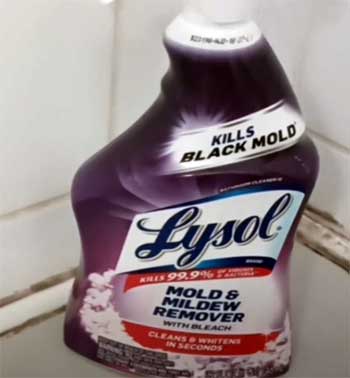
A few months ago, I moved into an older apartment with a bathroom that screamed “neglect.”
The shower tiles were speckled with dark patches, and the caulking looked like it was hosting a mold convention.
I’m no stranger to cleaning, but this was next-level gross.
After some research, I grabbed a bottle of Lysol Mold & Mildew Remover with Bleach from the store, drawn by its promise to obliterate mold and mildew without endless scrubbing.
Spoiler alert: it lived up to the hype.
The first time I used it, I was skeptical. I’d tried other cleaners before, and they either required elbow grease or left the mold barely fazed. I sprayed Lysol directly onto the grimy tiles, making sure to cover every suspicious spot.
The instructions said to let it sit for five minutes, so I set a timer and waited. The bleach smell was noticeable but not overwhelming, and I cracked a window to keep things airy. After five minutes, I rinsed the area with water, and—boom—the black spots were gone.
Like, gone gone. The grout looked whiter than it probably had in years, and I didn’t even need to scrub. It felt like magic.
I also tested it on a musty corner of my kitchen sink where mildew had started creeping in. Same deal: a quick spray, a short wait, and a rinse. The results were just as impressive. The sink gleamed, and that funky smell disappeared. I was hooked.
Since then, I’ve used it on my bathroom sink, toilet, and even a damp basement wall. Each time, it tackled the problem with minimal effort. It’s become my go-to for any moldy or mildewy situation, and I love that it’s so straightforward to use.
Just spray, wait, rinse, and admire your work. It’s the kind of product that makes you feel like a cleaning superhero.
Pros of Lysol Mold & Mildew Remover
- Kills Mold and Mildew Like a Champ
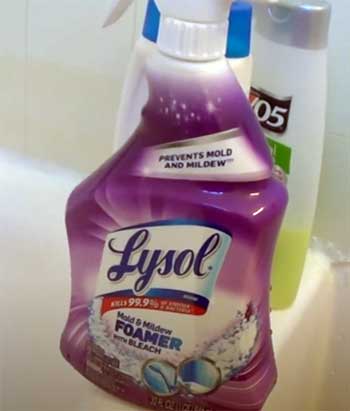
Let’s start with the big one: this stuff works.
Lysol Mold & Mildew Remover doesn’t mess around when it comes to wiping out mold, mildew, and 99.9% of viruses and bacteria.
I saw it obliterate black mold in my shower with one application.
The bleach-based formula is a powerhouse, cutting through grime and leaving surfaces spotless.
Whether it’s tiles, grout, or even stainless steel, it gets the job done.
I’ve used it on multiple surfaces, and it consistently delivers. If you’re dealing with stubborn mold, this is your weapon of choice.
- No Scrubbing Needed (Most of the Time)
One of the best parts? You barely need to lift a finger. Unlike other cleaners that had me scrubbing until my arms ached, Lysol does the heavy lifting. Spray it on, let it sit for five minutes, and rinse. In my shower, the mold vanished without any scrubbing.
For tougher stains, like deeply embedded mildew, a light wipe with a sponge might help, but it’s minimal effort compared to other products. This is a huge win for anyone who wants results without turning cleaning into a workout.
- Whitens and Brightens Surfaces
This isn’t just about killing mold—it’s about making your surfaces look brand new. The bleach in Lysol’s formula whitens grout and tiles, giving your bathroom or kitchen a fresh, sparkling finish. My shower grout went from dingy gray to crisp white, and it was honestly satisfying to see.
It’s like a mini makeover for your surfaces, and it makes the whole room feel cleaner. If you’re obsessed with that “just cleaned” glow, this product delivers it in spades.
- Easy to Find and Affordable
You don’t have to hunt this down at a specialty store. Lysol Mold & Mildew Remover is available at places like Target, Walmart, and Amazon, often for around $4–$6 for a 32-ounce bottle. That’s a steal for how effective it is. I picked mine up during a grocery run, and it didn’t break the bank.
Plus, a little goes a long way—one bottle has lasted me months, even with regular use in my mold-prone bathroom.
- Safe for Plumbing and Septic Systems
I was worried about using a bleach-based cleaner in my apartment, which has an older septic system. But Lysol’s non-abrasive formula is designed to be safe for plumbing and septic systems, so I didn’t have to stress about causing damage.
I’ve used it on sinks, toilets, and tubs without any issues. Just make sure to rinse metal surfaces quickly to avoid potential pitting, and you’re good to go.
Not-So-Good Parts of Lysol Mold & Mildew Remover
- Strong Bleach Smell
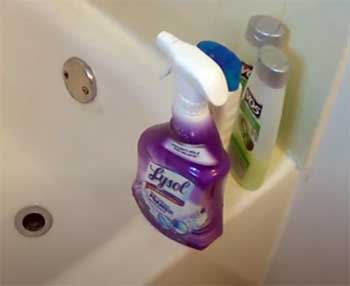
Let’s be real: the bleach smell is no joke. It’s not overpowering to the point of making you flee the room, but it’s strong enough that you’ll want good ventilation.
I always open a window or turn on the bathroom fan when I use it.
If you’re sensitive to chemical odors or have respiratory issues like asthma, this might bother you.
I found the smell manageable, but it’s something to consider, especially in small, enclosed spaces.
- Not Ideal for Porous Surfaces
Here’s a bummer: Lysol works wonders on hard, non-porous surfaces like tiles and glass, but it struggles with porous materials like wood or drywall. I tried it on a slightly moldy wooden windowsill, and while it killed some surface mold, the deeper stuff didn’t budge.
For porous surfaces, you might need a different product or professional help. It’s not a dealbreaker, but it limits the product’s versatility.
- Potential for Surface Damage
You’ve got to be careful with this one. The bleach can damage certain surfaces like old porcelain, plastic laminate, or marble if left on too long. I learned this the hard way when I accidentally left it on a painted surface for too long and noticed slight discoloration.
Always follow the instructions—spray, wait five minutes, and rinse. And don’t let it sit on metal for too long, or you might end up with pitting. It’s powerful, so respect its strength.
- Spray Bottle Issues
The spray bottle is convenient, but it’s not perfect. A couple of times, I noticed it leaking a bit when I tilted it, which was annoying. It’s not a major issue, but it can make a mess if you’re not careful. I started holding it upright and keeping a rag handy to catch any drips.
Some folks online mentioned similar issues, so it’s not just me. A better-designed nozzle would make this product even easier to use.
Tips For Using Lysol Mold & Mildew Remover
- Prep Your Space Properly: Before you start spraying, set yourself up for success. Clear out any items like towels or bath mats that could get splashed with bleach. I learned this after accidentally getting some on a favorite towel—yep, it’s ruined now. Open a window or turn on a fan to keep the air moving, especially since the bleach fumes can be strong. If you’ve got gloves, wear them to protect your hands. I also keep a sponge or cloth nearby for any light wiping that might be needed.
- Follow the Five-Minute Rule: The key to Lysol’s magic is letting it sit for five minutes. Don’t rush this step! I set a timer on my phone to make sure I’m giving it enough time to work. If you rinse too soon, you might not get the full mold-killing effect. For really stubborn spots, I sometimes let it sit a bit longer (up to 10 minutes) before rinsing, but don’t overdo it on sensitive surfaces. Timing is everything with this product.
- Rinse Thoroughly: After letting it sit, rinse the surface well with water. This is super important for metal surfaces like faucets or showerheads to prevent corrosion. I use a handheld showerhead to blast away the residue, but a bucket of water or a wet sponge works too. Don’t skip this step, or you might end up with damage over time. I also wipe down the area with a clean cloth afterward to make sure it’s completely clean.
- Prevent Mold from Coming Back: Lysol can stop mold regrowth for up to a week, but you’ve got to stay proactive. I keep a small squeegee in my shower and wipe down the tiles after every use to reduce moisture. I also wash my shower curtain regularly to keep mildew at bay. If your bathroom is prone to dampness, consider a dehumidifier or a fan to keep the air circulating. These little habits make a big difference in keeping mold away.
- Store It Safely: This stuff is potent, so store it out of reach of kids and pets. I keep mine in a locked cabinet under the sink. Also, check the bottle for leaks before storing it—I learned to keep it upright to avoid any spills. If you’re refilling a spray bottle, make sure it’s tightly sealed. A little caution goes a long way with a bleach-based product like this.
Comparing Lysol To Other Mold and Mildew Removers
Let’s talk about how Lysol stacks up against other big players in the mold and mildew remover game. I’ve tried a few competitors, and here’s how they compare in a real-world showdown.
- Clorox Tilex Mold and Mildew Remover
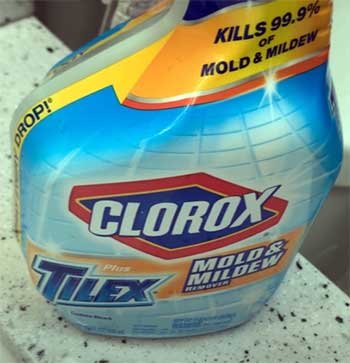
Clorox Tilex is Lysol’s closest rival, and it’s also a bleach-based spray that promises to kill 99.9% of mold and mildew.
I used Tilex in my old apartment, and it’s effective, no doubt. Like Lysol, it requires minimal scrubbing and whitens surfaces beautifully.
However, I found Tilex’s smell a bit harsher, and it seemed to linger longer.
Tilex also comes in a 32-ounce bottle, but it’s pricier—often $6–$8. Lysol edges out slightly for being more budget-friendly and having a less intense odor.
If you’re choosing between the two, it’s a close call, but Lysol’s price and ease of use give it a slight advantage.
- RMR-141 Disinfectant Spray
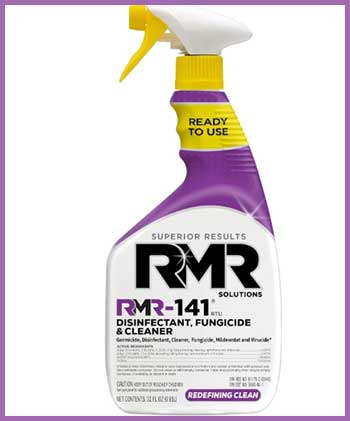
RMR-141 is a bleach-free option that’s EPA-registered and boasts a citrus scent.
I gave it a shot on some bathroom tiles, and it worked well for light mildew but struggled with tougher black mold.
It’s great if you’re sensitive to bleach or want a milder smell, but you might need to scrub more, and it takes longer (10 minutes) to work.
It’s also pricier, around $8–$10 for a 32-ounce bottle.
Lysol wins for speed and power, but RMR-141 is a solid choice for eco-conscious folks or those with allergies.
- Mold Armor Rapid Clean Remediation
Mold Armor is another bleach-based contender that’s fast-acting and versatile. I tried it on a concrete basement floor, and it worked quickly with minimal effort. However, it’s not as effective at whitening grout as Lysol, and the spray bottle felt less precise, with more overspray.
Priced similarly to Lysol, it’s a good alternative, but I prefer Lysol’s ability to make surfaces sparkle. If you need something for outdoor surfaces like concrete, Mold Armor might have a slight edge, but for bathrooms, Lysol is king.
- CLR Mold & Mildew Stain Remover
CLR’s bleach-free formula is designed more for stain removal than killing mold outright. I used it on a fabric shower curtain, and while it tackled some light stains, it didn’t fully eliminate mildew.
It’s safer for porous surfaces and has no bleach smell, which is nice, but it requires multiple applications for tough jobs. At $7–$9, it’s pricier than Lysol and less effective for heavy mold. If you’re dealing with stains on delicate surfaces, CLR is worth a look, but for serious mold, stick with Lysol.
- Concrobium Mold Control Spray
Concrobium is another bleach-free option that’s odorless and leaves a barrier to prevent mold regrowth. I tested it on a basement wall, and it worked decently but didn’t whiten like Lysol. It’s great for those with sensitivities, but it’s slower (needs 10 minutes) and less powerful on stubborn mold.
At $10–$12, it’s also more expensive. Lysol’s faster results and lower price make it the better pick for most home use, but Concrobium is a good choice for ongoing prevention.
Frequently Asked Questions (FAQ)
Yes, it works incredibly well on non-porous surfaces like tiles, glass, and metal. I’ve used it on my shower and kitchen sink, and it wiped out mold and mildew with minimal effort. It kills 99.9% of mold variants and bacteria when used as directed, and it prevents regrowth for up to a week. For deep mold in porous materials, though, you might need something stronger or professional help.
Lysol is a top contender for non-porous surfaces, thanks to its effectiveness and septic-safe formula. However, its bleach content means you need good ventilation and caution with sensitive surfaces. For a safer, bleach-free option, RMR-141 or Concrobium are great, especially for those with allergies or sensitivities. They’re less harsh but may require more effort. It depends on your priorities—Lysol for power, or alternatives for gentler use.
No, Lysol Mold & Mildew Remover is not discontinued as of July 2025. It’s widely available at retailers like Target, Walmart, and Amazon. I’ve seen it consistently stocked in stores and online, so you shouldn’t have trouble finding it. Always check the label to ensure you’re getting the bleach-based formula if that’s what you need.
Lysol needs about five minutes of contact time to effectively kill mold and mildew spores. I spray it on, let it sit for five minutes, then rinse. For tougher spots, you might let it sit a bit longer (up to 10 minutes), but don’t overdo it on sensitive surfaces to avoid damage. Always follow the instructions for best results.
Why Lysol Mold & Mildew Remover Is A Must-Have?
If mold and mildew are wreaking havoc in your home, Lysol Mold & Mildew Remover is your ticket to a cleaner, fresher space. It’s affordable, powerful, and easy to use, making it a no-brainer for tackling bathroom and kitchen grime.
From my sparkling shower to my mold-free sink, this product has earned its spot in my cleaning routine.
Grab a bottle, follow the tips I’ve shared, and say goodbye to those pesky spots. Your home deserves to shine, and Lysol makes it happen.
